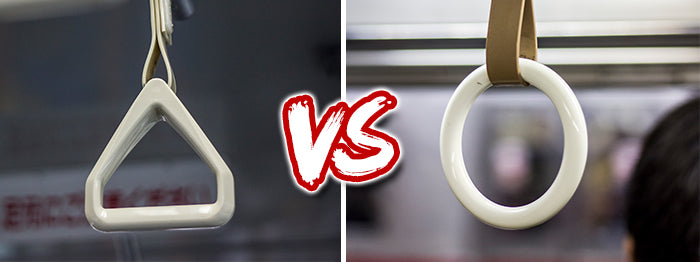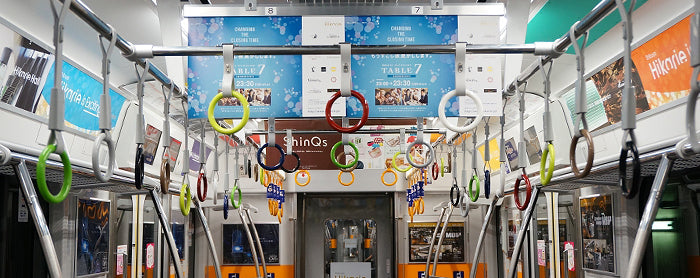The Tsurikawa Story
Stolen in trains by our local young gangsters, also known as bosozokus, the tsurikawas were originally attached inside cars so passengers could slide their wrist inside the ring and safely hang their body outside the window.

They quickly became the symbol of a reckless youth and bosozokus started to attach them outside heavily modified bikes and cars to show rebellion and disrespect to authority.
Nowadays, hardcore Japanese car enthusiasts are still flaunting them to express their freedom.
It’s your turn to uphold the tradition!

The Tsurikawa Story
In Japan, the word “tsurikawa” describes objects, usually suspended, that help standing passengers to keep their balance while the vehicle is in motion. In the early days of Japanese public transportation, those handles were made of leather, hence the name “tsurikawa” which literally means “hang” (tsuri吊) and “leather” (kawa革). Although “tsurikawa” is the name commonly used, some people also call them “tsuriwa” (wa means ring). Manufacturers and transport companies often refer to “tsurite” (te means hand), a more technical and contemporary term.
Evolution
During the WWII, the use of skin for tsurikawas was banned and manufacturers used other materials to produce their handles. After the conflict, leather came back strong and became a standard again until the mid-fifties. Other cheaper materials started then to emerge and new standards in safety were about to seal its destiny.
The Mikami area
Leather was easy to cut or stretch and wouldn’t hold well with fire. Transport companies started to search for a better product and that’s when a young man native of Osaka working for a cotton-spinning company came up with a great idea. Toyozaburou Mikami developed a new two-ply polyvinyl belt reinforced with fiber and presented it to the local Hanshin train company in October 1952. After 2 years of testing and development, Hanshin adopted it and equipped all its new trains (Type 300) with it! The Toyosan, that’s the name Mikami-san gave to his product, is now the most popular tsurikawa, not only in Kansai area but in the whole country! On a side note, JDM Tsurikawa products also use nylon-reinforced polyvinyl straps similar to Mikami’s to insure strength and durability.
Type/shapes
Tsurikawas come in various types, shapes and colors. The most common ones feature a handle usually round, triangular and sometimes pentagonal (very rare). The very first Japanese tsurikawas didn’t have handles but only a strap instead. In other countries, it is also pretty common to see simple ropes with a ball-shaped bottom.

Triangle handles (shape developed on old household iron handles) are known to be the most comfortable tsurikawas to grab. In 1933, this was the only type available in Osaka subways. Triangle handles were also pretty common in JR (Japan Railway) trains and Tokyo Metro until the mid-seventies.
The round handle tsurikawa slowly took over to become today the mainstream handle due to human and ergonomics factors. Its shape allows you to slide your wrist into it and rest your body for example. You can also rotate it and make sure not to grab a part grabbed by someone else before.
Until recently, most of the tsurikawas featured white rings with either light grey, white or light brown straps. In the 80’s, Shikeisei Electric Railroad started to use yellow rings to highlight the priority seats. It’s now common for companies to install different color combos near special seats.

The ring orientation has also been subject to serious studies (and probably endless meetings). Round rings are now installed parallel to the vehicle motion direction while triangle ones are hanged perpendicularly. This pattern is supposed to help passengers’ comfort and vehicle livability.
Let me out!
In commuter trains, the tsurikawas installed near the exits are a sensitive topic. If you install a tsurikawa there, you might slow down the in and out traffic. But if you don’t, people can’t keep their balance if there’s nothing around to hold on to. In the early days, in trains before the 72 series, JR wasn’t using tsurikawas around doors area but vertical pole instead. In the 101 and 103 series, the pole was horizontal, above customer’s head. However, increase in complains forced train companies to install handles everywhere. In order to limit the inconvenience, they developed articulated handles that would allow the tsurikawa to stay out of the way if not pulled down by a passenger. Those systems, inspired from the Rico handles invented by US train companies, can still be seen in some old Japanese trains. Keihan, which took the Japanese patent for this tsurikawa, equipped some of its trains (Kintetsu 820) with a this system. Due to a high production coat, it’s been slowly replaced by regular units since 2000. Companies now “play” with the strap lengths to have the rings optimally positioned.
Special Tsurikawas
In Japan, we love special editions and limited products! And it is especially true with tsurikawas! Train companies know that and are never short of ideas! The Maihama resort line (Disney Land Tokyo) for example has rings with round Mickey ears and in some carts all sort of Disney inspired handles.

In Tokyo, the Seibu 30000 series feature egg-shaped tsurikawas. Kyoto City Tram which is preserved in the Meijimura museum Meijimura has wooden tsurikawa, replicas from the original old handles. The most famous “special” handle is without a doubt the one you can find, if you’re lucky, in the Eizan Electric Railway (Kyoto as well). The company had the great idea to install a unique pink heart-shaped tsurikawa in one of its 22 carts. 1 single tsurikawa, out of 1028! And to spice up the game a bit more, they even change its position every few days! This idea originally came from a train employee of Izuhakone Railway Sunzu Line and became a national topic. The heart tsurikawa in Sunzu Line even appeared in the famous TV drama “Gomen ne Seishun!” (Episode 4) in 2014! JR East and Seibu Railway (Saitama) install heart shaped tsurikawas is some of their carts around Valentine’s Day as well.

You don’t need to be a marketing master to understand that tsurikawas also offers a perfect spot for advertisement. Right in front of you face! Thus, straps are sometimes wrapped in an oval piece of plastic, to support small, but effective, adhesive advertisements.

The villains...
The bosozokus (pronounce bo-o so-o zoku, with long “o”) first appeared in the late 50’s, during the Japanese automotive industry boom, as motorbike gangs. The movement quickly spread to cars enthusiasts, and local roads became the theater for all kind of illegal performance. The members of those highly codified groups spend a lot of time and effort in modifying their rides, using prominent body extensions, colorful paints, stickers, and sometimes extra-long exhaust pipes. The bosozoku outfit (called Tokko-fuku) includes a long coat with all kind of prints (team name, militaristic slogans, Japanese Imperial flag…), long boots, a surgical mask (to conceal their identity and not because they’re sick), a long headband (called Hachimaki) and a metal pipe, wood stick or baseball bat. This cliché, widely used in manga or movies, reflect only a small part of bosozoku’s dressing codes, most of them using more practical and (a bit) less flashy clothes.

Group of bosozukus and their decorated bikes.
In the 90’s, bosozokus were Japanese police number one target. They develop all kind of traps and strategies (sometimes very funny) to bust the bikers and drivers. Some of the fights and chases were pretty intense though and the cops showed no mercy for the motorized bandits. Both sides played that game for a while but the number of bosozokus eventually decreased slowly. Nowadays, ruthless bosozokus are mostly extinguished but the legacy lives through brave youngsters who still ride their loud bikes at night. Don’t worry, most of them are nice folks and mean you no harm!
Video of a typical bosozoku car:


